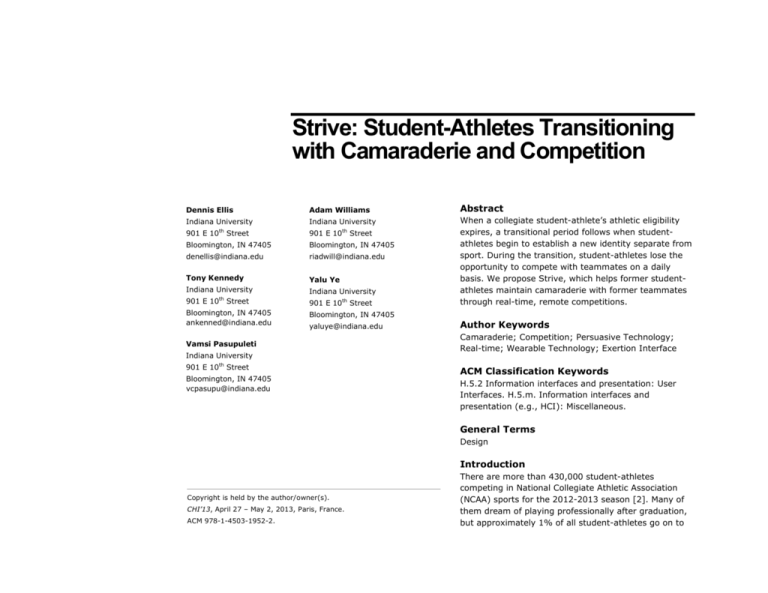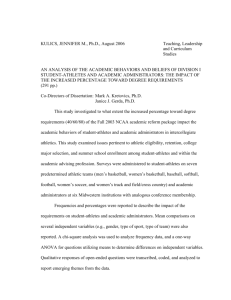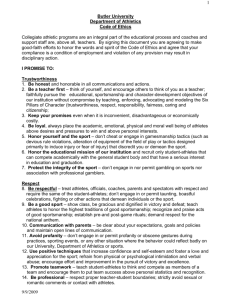Strive: Student-Athletes Transitioning with Camaraderie and
advertisement

Strive: Student-Athletes Transitioning with Camaraderie and Competition Dennis Ellis Adam Williams Abstract Indiana University Indiana University 901 E 10th Street 901 E 10th Street Bloomington, IN 47405 Bloomington, IN 47405 denellis@indiana.edu riadwill@indiana.edu Tony Kennedy Yalu Ye When a collegiate student-athlete’s athletic eligibility expires, a transitional period follows when studentathletes begin to establish a new identity separate from sport. During the transition, student-athletes lose the opportunity to compete with teammates on a daily basis. We propose Strive, which helps former studentathletes maintain camaraderie with former teammates through real-time, remote competitions. Indiana University 901 E 10th Street Bloomington, IN 47405 ankenned@indiana.edu Indiana University 901 E 10th Street Bloomington, IN 47405 yaluye@indiana.edu Vamsi Pasupuleti Indiana University 901 E 10th Street Bloomington, IN 47405 vcpasupu@indiana.edu Author Keywords Camaraderie; Competition; Persuasive Technology; Real-time; Wearable Technology; Exertion Interface ACM Classification Keywords H.5.2 Information interfaces and presentation: User Interfaces. H.5.m. Information interfaces and presentation (e.g., HCI): Miscellaneous. General Terms Design Introduction Copyright is held by the author/owner(s). CHI’13, April 27 – May 2, 2013, Paris, France. ACM 978-1-4503-1952-2. There are more than 430,000 student-athletes competing in National Collegiate Athletic Association (NCAA) sports for the 2012-2013 season [2]. Many of them dream of playing professionally after graduation, but approximately 1% of all student-athletes go on to Figure 1. Low-fidelity prototype of Strive as seen during design evaluation. Figure 2. Affinity Diagram to narrow target user group and domain. compete in professional sports [8]. The vast majority of student-athletes face a transitional period from life as a competitive athlete to life after sports. Some studentathletes make the transition successfully, yet there are “significant numbers of athletes for whom the adjustment is difficult, incomplete, and traumatic [3].” Affecting Intercollegiate Student-Athletes”, which is designed to help athletes prior to post-athletic transition. While the funded initiatives are designed to help student-athletes while they are in college, little is being done to help former student-athletes after graduation when the transitioning is actually occurring. Student-athletes at the collegiate level have been competing in athletic events their entire lives. As such, competition is profoundly ingrained into the identity of student-athletes. In the words of a former studentathlete, “we grew up playing together and always had that sense of competition... you always wanted to be better.” This type of sustained, high-level competition developed by overcoming adversity together engenders a special type of camaraderie built between collegiate student-athletes as expressed by an interviewee: “Because we spend so much time together, sometimes weeks where your teammates are the only people you talk to, you know each other at your most exhausted, almost at your core.” We propose Strive (Figure 1), a wristband designed to enable remote competition between former college teammates in real-time scenarios. Primarily, we designed Strive as a piece of wearable technology to encourage real-time and in-situ collaboration between former college teammates. Strive could be incorporated into a larger ecosystem involving web, mobile, or tablet applications. Wearable technology was chosen because of the opportunity for seamless integration into a variety of sporting environments, thus promoting competition and camaraderie across sporting domains. The intersection of physical activity and technology has gained the attention of HCI researchers over the past few years. People working in the area of persuasive technology have produced many products designed to encourage people to be fit. More, many designers have experimented with exertion interfaces, such as RunWithUs, which is designed to help connect remote joggers explore the potential for remote social opportunities combined with exercise [5]. Florian Mueller, who helped design Jogging over a Distance, found that audio communication in exertion interfaces can promote a deep sense of presence [7]. In addition to the field of HCI, universities like The Ohio State University offer a course called “Contemporary Issues Design Process Many different groups could potentially benefit from collaboration and crowdsourcing; we chose to use affinity diagramming to rapidly narrow down on a user group and problem space. After exploring groups such as young teachers, children of divorced parents, and people who collaborate through music rehearsal (Figure 2), we decided to primarily focus on support for former athletes dealing with depression. Then, we did a literature review of psychological journals, HCI publications, and other academic and professional literature regarding our chosen domains. Through our literature review we discovered that “when putting an end to their sporting career, athletes lose an important part of themselves”, and more specifically “some student-athletes sacrifice other aspects of their identity in the name of sport” [1, 6]. At some point in time, all athletes must retire from their sporting career, making the transitional period for all athletes a valuable period for study. Further, we narrowed our focus to collegiate student-athletes who are going through a transition after graduation. Figure 3. Categorizing the four aspects of transition discovered during interviews with former student-athletes. Although our literature review enabled us to focus on a more specific domain, we lacked understanding of the nature of the problems facing former student-athletes. To gain a more direct understanding of these problems, we interviewed seven former student-athletes who either were currently experiencing the transition or had transitioned within the past five years. One of our group members was a former collegiate baseball player, which enabled us to gain access to a group of former collegiate athletes. Semi-structured interviews gave us the opportunity to explore the issues these former student-athletes experienced. Next, we wanted a more personal narrative from the interviewees, so we led a focus group of five former student-athletes. We began the discussion with questions such as, “How have you transitioned after collegiate sports?”, “What went well for you during the transition?”, and “What did you struggle with during transition?” Out of the responses, the most important insights were: "(Five years later) I have yet to form the bonds like I formed with teammates in college." “I was chasing the feeling I had in college.” Figure 4. Home screen of Strive wristband showing a list of friends and teams. Nearly all interviewees mentioned camaraderie or competition, which led us to further investigate these aspects of transition (Figure 3). We focused on a solution that would help former student-athletes maintain camaraderie through competition. We began sketching concepts and generated 20 different concepts that could help former student-athletes compete remotely in real-time. The concepts included a virtual living room as a competition arena, an interactive bouncy ball to facilitate competitions, and a digital card to display and send challenges. We decided on wearable technology because it could provide a convenient way to communicate with teammates and give real-time scorekeeping feedback on competition progress without distracting from the competitions. After conceptualizing different types of wearable technologies like an armband, ring, or necklace, we decided a wristband would allow for the most ease of use during competitions. Next, we presented our concept as a storyboard to peers to gain the perspective of other designers. The critique exposed a lack of familiarity with current exemplars. To address, we explored three different exemplars of wearable technology designed for physical activity including FitBit, Jawbone Up, and Nike FuelBand. By speaking with a designer affiliated with the Nike FuelBand, we learned that our concept is different because it is a "real-time simulation, giving you someone to compete against in real-time." System The Strive system consists of two components, a wristband and web application. The primary functions of the wristband are to set up new challenges, track the progress of a challenge, send voice messages, and set up a manually-scored challenge (Figures 4,5). While the wristband is more concerned with facilitating competition, the web application is used for monitoring both individual and team challenge progress, discovering unique user-generated challenges, and providing a forum where community collaboration takes place. Figure 5. Challenge screen of Strive wristband. Figure 6. The diagram illustrates how an athlete with Strive would interact with other athletes, teams of athletes, and the web application. Real-time Challenges Challenges are broadly classified into two categories, synchronous challenges and asynchronous challenges, which can take place in a collocated or remote setting. Synchronous challenges occur simultaneously and offer real-time feedback. For example, two teammates compete in a three-mile running challenge at the same time, which enables them to monitor each other’s pace with the wristband as if they were running side-by-side. Figure 7. Strive wristband displaying realtime progress of a challenge. Asynchronous challenges offer simulated real-time feedback. For example, instead of running three miles at the same time, the two teammates take part in a challenge measuring the time it would take for the first competitor to get to three miles thus creating a goal for the second competitor to beat (Figure 7). Each college team has their own culture of competition; Strive enables each team to compete in ways that revive competitive experiences from college. Athletes are encouraged to create their own unique challenges through the web application that would make use of either the manual scorekeeping function or measurable parameters such as speed, distance, or altitude. Usergenerated challenges could utilize the different aspects of Strive to enable former teammates to create challenges unique to their culture of competition. Ecology and Feasibility Strive is designed to make use of the existing ecology of devices by integrating with web and mobile, rather than existing as a stand-alone device. It adds value to the user’s ecology of devices by not getting in the way of challenges while seamlessly integrating with the network capabilities in existing mobile devices. The wristband can use either Bluetooth or a network connection to its advantage. Strive keeps the mobile device out of harm’s way by enabling the user to wear the wristband during challenges. Strive connects to a smartphone allowing for real-time feedback through both voice messages and a scoreboard. Design Evaluation After narrowing down to wearable technology in realtime competitions, we conducted follow up interviews with former collegiate student-athletes to gain a deeper understanding of how they would make use of the realtime challenges. The feedback led us to emphasize the unique challenges that former student-athletes would want to participate in with the use of Strive. Additionally, Strive’s ability to provide real-time scorekeeping and verbal feedback were key to the experience of the challenges. Figure 8. Strive wristband worn during first design evaluation. Next, we decided to test our design through a challenge scenario with two former student-athletes. To overcome the limitations of a low-fidelity prototype wristband during testing, we used a smartphone walkie-talkie app and scoreboard app to simulate both Strive capabilities. Based on participant feedback, we created two different design evaluation scenarios that would test the experience of using Strive. The goal of the design evaluations was to see how former studentathletes would react when wearing the wristband and competing with scorekeeping and verbal feedback. The first design evaluation included two former student-athletes (Figure 8). The scenario consisted of a two-part basketball challenge where one subject completed a short timed run, followed by manually scored free throw contest that involved a best-of-ten shot challenge. In between the two challenges, verbal communication was exchanged between the two subjects. While the two subjects were able to successfully complete the challenges, the results did not yield many applicable insights because the two former athletes were not teammates in college. the first challenge. Then, the first participant began the second part of the challenge by completing a manually scored softball throwing challenge while the second participant was outside the gymnasium. The second participant was able to see the score of the first participant through the scoreboard app while the activity was taking place. The goal was to simulate real-time scorekeeping and feedback while the athletes were in separate locations. After the two-part challenge, we asked the athletes to come up with their own unique competition using Strive. Based on their team experience, the two athletes created a competition that involved fielding a softball and throwing to a target on the run, something they called a “Do-or-Die” play. Before they began, both athletes had expectations of how the competition would play out because, after years of competing and training together, they had an awareness of each other’s skills and capabilities. Following the design evaluation, we interviewed the two former teammates to get feedback on their experience. “It makes me want to play again...” Figure 9. Strive wristband used by two former teammates during second design evaluation. A second test was needed, so we searched for two former student-athletes who were teammates during college (Figure 9). The second design evaluation consisted of two-part softball challenge in a gymnasium. During the first part, one subject completed a timed run around the bases, while the second participant was outside the gymnasium. The first participant followed the run by verbally communicating the result through the walkie-talkie app to the second participant. After the second participant completed the run, “trash talking” was initiated through the walkie-talkie app by the first participant who won “And I (first competitor) think knowing that she would see [the results] later, I am trying to get a better score so she can’t beat me.” “It creates competition; we always had competition.” Future Strategies The core strengths of Strive could easily be expanded to allow for a wider range of competitions between athletes at different universities. Fierce college rivalries could extend beyond graduation and promote teamwork and competition between universities. More, Strive could be used to help gaming evolve to include non-traditional gaming domains, such as shopping, by creating a situation where “the game player becomes unchained from the console and experiences a game that is interwoven with the real world and is potentially available at any place and any time [4].” Additionally, Strive could be useful for military personnel looking to maintain camaraderie with fellow soldiers after coming home from deployment, public health officials looking for ways to improve community health as a persuasive technology, and physical trainers who are looking for unique ways to motivate or help rehabilitate their clients. Conclusion An inevitable reality of being a collegiate studentathlete is retiring from high-level competition. For some of these student-athletes, the transition from being a student-athlete to a life after NCAA competition is difficult. We focused on the specific aspects of competition and camaraderie as a possible solution for former student-athletes struggling with the transition. Strive enables former student-athletes to maintain camaraderie once possessed with former teammates through real-time competition in an effort to ease the difficulties faced during the transition to an identity less defined by sport. Acknowledgements We thank Dr. Jeff Bardzell, Dr. Shaowen Bardzell, Dr. Marty Siegel, and Dr. Erik Stolterman for guidance. References [1] 2010. IOC Athletic Career Programme: Athletic Identity and Sport Transition. http://www.olympic.org/Documents/elite_athletes/ATH LETIC_IDENTITY.pdf. [2] 2012. About the NCAA. Membership. http://www.ncaa.org/wps/wcm/connect/public/ncaa/ab out+the+ncaa/membership+new. [3] Baile, P., Understanding Retirement from Sports: Therapeutic Ideas for Helping Athletes in Transition. The Counseling Psychologist 21, (1993), 399-410. [4] Benford, S., Magerkurth, C., Ljungstrand, P. Bridgings the Physical and Digital in Pervasive Gaming. Communications of the ACM 48, 3 (2005). 54-57 [5] Gil-Casti ñeira, F., et al. RunWithUs: A Social Sports Application in the Ubiquitous Oulu Environment. MUM 2011, ACM Press (2011), 195-204 [6] Houle, J., An Examination of the Relationship Between Athletic Identity and Career Maturity in Student-Athletes. Diss. Auburn University, 2010. [7] Mueller, F., O’Brien, S., & Thorogood, A. 2007. Jogging over a distance, Proceedings of the SIGCHI conference on Human factors in computing systems, April 28-May 03, 2007, San Jose, California, USA [8] Stankovich, C. E., Meeker, D. J., & Henderson, J. L. The positive transition model of sport retirement. Journal of College Counseling, 4 (2001), 81-8



